Understanding the Effect of Stepwise Irrigation on Liquid Holdup and Hysteresis Behavior of Unsaturated Ore Heap
Abstract
:1. Introduction
2. Materials and Methods
2.1. Ore Samples and Its Pretreatment
2.2. Key Parameters of Liquid Retention
2.2.1. Relative Porosity (n*)
2.2.2. Liquid Holdup (θ) and Residual Liquid Holdup (θresidual)
2.2.3. Relative Unsaturated Liquid Holdup (θ′)
2.3. Experimental Design and Irrigation Scheme
2.4. Analytical Apparatus and Device
3. Results and Discussion
3.1. Liquid Spreading Performance in the Irrigation and Drainage Procedure
3.2. Residual Liquid Holdup Changes in the Irrigation and Drainage Procedure
3.3. Effect of Packed Crushed Ore Diameter on Liquid Retention
3.4. Residual Steady State Liquid Holdup Features under Stepwise Irrigation
3.5. Effect of Historical Irrigation Condition on Liquid Retention
4. Conclusions
Author Contributions
Funding
Data Availability Statement
Acknowledgments
Conflicts of Interest
References
- Petersen, J. Heap leaching as a key technology for recovery of values from low-grade ores—A brief overview. Hydrometallurgy 2016, 165, 206–212. [Google Scholar] [CrossRef]
- Yin, S.; Wang, L.; Kabwe, E.; Chen, X.; Yan, R.; An, K.; Zhang, L.; Wu, A. Copper Bioleaching in China: Review and Prospect. Minerals 2018, 8, 32. [Google Scholar] [CrossRef] [Green Version]
- Wang, L.; Yin, S.; Wu, A.; Chen, W. Synergetic bioleaching of copper sulfides using mixed microorganisms and its community structure succession. J. Clean. Prod. 2019, 245, 118689. [Google Scholar] [CrossRef]
- Watling, H.; Collinson, D.; Li, J.; Mutch, L.; Perrot, F.; Rea, S.; Reith, F.; Watkin, E. Bioleaching of a low-grade copper ore, linking leach chemistry and microbiology. Miner. Eng. 2013, 56, 35–44. [Google Scholar] [CrossRef]
- Yin, S.-H.; Wang, L.-M.; Wu, A.-X.; Chen, X.; Yan, R.-F. Research progress in enhanced bioleaching of copper sulfides under the intervention of microbial communities. Int. J. Miner. Met. Mater. 2019, 26, 1337–1350. [Google Scholar] [CrossRef]
- Van Staden, P.; Petersen, J. Towards fundamentally based heap leaching scale-up. Miner. Eng. 2021, 168, 106915. [Google Scholar] [CrossRef]
- Bouffard, S.C.; West-Sells, P.G. Hydrodynamic behavior of heap leach piles: Influence of testing scale and material properties. Hydrometallurgy 2009, 98, 136–142. [Google Scholar] [CrossRef]
- Brierley, C. Biohydrometallurgical prospects. Hydrometallurgy 2010, 104, 324–328. [Google Scholar] [CrossRef]
- Yin, S.; Wang, L.; Wu, A.; Free, M.L.; Kabwe, E. Enhancement of copper recovery by acid leaching of high-mud copper oxides: A case study at Yangla Copper Mine, China. J. Clean. Prod. 2018, 202, 321–331. [Google Scholar] [CrossRef]
- Wang, L.; Yin, S.; Wu, A. Ore agglomeration behavior and its key controlling factors in heap leaching of low-grade copper minerals. J. Clean. Prod. 2020, 279, 123705. [Google Scholar] [CrossRef]
- Yin, S.; Wang, L.; Wu, A.; Kabwe, E.; Chen, X.; Yan, R. Copper recycle from sulfide tailings using combined leaching of ammonia solution and alkaline bacteria. J. Clean. Prod. 2018, 189, 746–753. [Google Scholar] [CrossRef]
- Van Staden, P.; Petersen, J. The effects of simulated stacking phenomena on the percolation leaching of crushed ore, Part 1: Segregation. Miner. Eng. 2018, 128, 202–214. [Google Scholar] [CrossRef]
- Van Staden, P.; Petersen, J. The effects of simulated stacking phenomena on the percolation leaching of crushed ore, Part 2: Stratification. Miner. Eng. 2018, 131, 216–229. [Google Scholar] [CrossRef]
- Wang, L.; Yin, S.; Wu, A.; Chen, W. Effect of stratified stacks on extraction and surface morphology of copper sulfides. Hydrometallurgy 2019, 191, 105226. [Google Scholar] [CrossRef]
- Wu, A.; Yin, S.; Yang, B.; Wang, J.; Qiu, G. Study on preferential flow in dump leaching of low-grade ores. Hydrometallurgy 2007, 87, 124–132. [Google Scholar] [CrossRef]
- Wu, A.; Yin, S.; Qin, W.; Liu, J.; Qiu, G. The effect of preferential flow on extraction and surface morphology of copper sulphides during heap leaching. Hydrometallurgy 2009, 95, 76–81. [Google Scholar] [CrossRef]
- Lima, L.D.A. Liquid axial dispersion and holdup in column leaching. Miner. Eng. 2006, 19, 37–47. [Google Scholar] [CrossRef]
- Ilankoon, I.; Neethling, S. Transient liquid holdup and drainage variations in gravity dominated non-porous and porous packed beds. Chem. Eng. Sci. 2014, 116, 398–405. [Google Scholar] [CrossRef]
- Solomenko, Z.; Haroun, Y.; Fourati, M.; Larachi, F.; Boyer, C.; Augier, F. Liquid spreading in trickle-bed reactors: Experiments and numerical simulations using Eulerian–Eulerian two-fluid approach. Chem. Eng. Sci. 2015, 126, 698–710. [Google Scholar] [CrossRef] [Green Version]
- McBride, D.; Ilankoon, S.; Neethling, S.; Gebhardt, J.; Cross, M. Preferential flow behaviour in unsaturated packed beds and heaps: Incorporating into a CFD model. Hydrometallurgy 2017, 171, 402–411. [Google Scholar] [CrossRef] [Green Version]
- Ilankoon, I.; Neethling, S. The effect of particle porosity on liquid holdup in heap leaching. Miner. Eng. 2013, 45, 73–80. [Google Scholar] [CrossRef] [Green Version]
- Snyder, V.A. Statistical Hydraulic Conductivity Models and Scaling of Capillary Phenomena in Porous Media. Soil Science Society of America Journal 1996, 60, 771–774. [Google Scholar] [CrossRef]
- Fernando, W.A.M.; Ilankoon, I.; Rabbani, A.; Yellishetty, M. Inter-particle fluid flow visualisation of larger packed beds pertaining to heap leaching using X-ray computed tomography imaging. Miner. Eng. 2020, 151, 106334. [Google Scholar] [CrossRef]
- Teng, J.; Chu, J.-C.; Liu, C.; Xu, T.; Lien, Y.-F.; Cheng, J.-H.; Huang, S.; Jin, S.; Dang, T.; Zhang, C.; et al. Fluid Dynamics in Microchannels. In Fluid Dynamics, Computational Modeling and Applications; IntechOpen: London, UK, 2012. [Google Scholar]
- Fagan, M.A.; Ngoma, I.E.; Chiume, R.A.; Minnaar, S.; Sederman, A.; Johns, M.L.; Harrison, S.T. MRI and gravimetric studies of hydrology in drip irrigated heaps and its effect on the propagation of bioleaching micro-organisms. Hydrometallurgy 2014, 150, 210–221. [Google Scholar] [CrossRef] [Green Version]
- Velo, A.; Carvalho, D.; Hamada, M. Liquid distribution and holdup in the random packed column. Flow Meas. Instrum. 2018, 62, 176–185. [Google Scholar] [CrossRef]
- Ilankoon, I.; Neethling, S. Inter-Particle liquid spread pertaining to heap leaching using UV fluorescence based image analysis. Hydrometallurgy 2018, 183, 175–185. [Google Scholar] [CrossRef]
- Nimmo, J.R. Preferential flow occurs in unsaturated conditions. Hydrol. Process. 2011, 26, 786–789. [Google Scholar] [CrossRef]
- Cooper, S.; Peraltaa, C. Stepwise pumping approach to improve free phase light hydrocarbon recovery from unconfined aquifers. J. Contam. Hydrol. 1995, 18, 141–159. [Google Scholar] [CrossRef] [Green Version]
- McBride, D.; Gebhardt, J.; Croft, T.; Cross, M. Modeling the hydrodynamics of heap leaching in sub-zero temperatures. Miner. Eng. 2016, 90, 77–88. [Google Scholar] [CrossRef] [Green Version]
- Fernando, W.A.M.; Ilankoon, I.; Chong, M.N.; Syed, T.H. Effects of intermittent liquid addition on heap hydrodynamics. Miner. Eng. 2018, 124, 108–115. [Google Scholar] [CrossRef]
- Fan, Y.; Jacob, K.V.; Freireich, B.; Lueptow, R. Segregation of granular materials in bounded heap flow: A review. Powder Technol. 2017, 312, 67–88. [Google Scholar] [CrossRef]
- Ilankoon, S.K. Hydrodynamics of Unsaturated Particle Beds Pertaining to Heap Leaching; Imperial College London: London, UK, 2012. [Google Scholar]
- Blackmore, S. The Role of Hydrology, Geochemistry and Microbiology in Flow and Solute Transport Through Highly Heterogeneous, Unsaturated Waste Rock at Various Test Scales; The University of British Columbia: Vancouver, BC, Canada, 2015. [Google Scholar] [CrossRef]
- Zhang, S.; Liu, W.; Granata, G. Effects of grain size gradation on the porosity of packed heap leach beds. Hydrometallurgy 2018, 179, 238–244. [Google Scholar] [CrossRef]
- Ilankoon, S.; Neethling, S. Hysteresis in unsaturated flow in packed beds and heaps. Miner. Eng. 2012, 35, 1–8. [Google Scholar] [CrossRef]
- Ghorbani, Y.; Becker, M.; Mainza, A.; Franzidis, J.-P.; Petersen, J. Large particle effects in chemical/biochemical heap leach processes—A review. Miner. Eng. 2011, 24, 1172–1184. [Google Scholar] [CrossRef]
- Blackmore, S.; Smith, L.; Mayer, K.U.; Beckie, R.D. Comparison of unsaturated flow and solute transport through waste rock at two experimental scales using temporal moments and numerical modeling. J. Contam. Hydrol. 2014, 171, 49–65. [Google Scholar] [CrossRef]
- Mayergoyz, I. Mathematical models of hysteresis. IEEE Trans. Magn. 1986, 22, 603–608. [Google Scholar] [CrossRef] [Green Version]
- Extrand, C.W. Contact Angles and Their Hysteresis as a Measure of Liquid−Solid Adhesion. Langmuir 2004, 20, 4017–4021. [Google Scholar] [CrossRef]
- Zeidman, B.D.; Lu, N.; Wu, D.T. Hysteresis of liquid adsorption in porous media by coarse-grained Monte Carlo with direct experimental validation. J. Chem. Phys. 2016, 144, 174709. [Google Scholar] [CrossRef] [PubMed]
- Wang, L.-M.; Yin, S.-H.; Wu, A.-X. Visualization of flow behavior in ore-segregated packed beds with fine interlayers. Int. J. Miner. Met. Mater. 2020, 27, 900–909. [Google Scholar] [CrossRef]
- Yin, S.-H.; Wang, L.-M.; Chen, X.; Wu, A.-X. Effect of ore size and heap porosity on capillary process inside leaching heap. Trans. Nonferr. Met. Soc. China 2016, 26, 835–841. [Google Scholar] [CrossRef]
- Nimmo, J.R. Porosity and pore-size distribution. In Encyclopedia of Soils in the Environment; Elsevier: Amsterdam, The Netherlands, 2005; pp. 295–303. [Google Scholar]
- Ram, R.; Beiza, L.; Becker, M.; Pownceby, M.; Chen, M.; Yang, Y.; Yang, S.; Petersen, J. Study of the leaching and pore evolution in large particles of a sulfide ore. Hydrometallurgy 2020, 192, 105261. [Google Scholar] [CrossRef]
- Robertson, S. Development of an integrated heap leach solution flow and mineral leaching model. Hydrometallurgy 2017, 169, 79–88. [Google Scholar] [CrossRef]
- Chung, T.-W. Predictions of moisture removal efficiencies for packed-bed dehumidification systems. Gas Sep. Purif. 1994, 8, 265–268. [Google Scholar] [CrossRef]
- Wang, J.-P.; Gallo, E.; François, B.; Gabrieli, F.; Lambert, P. Capillary force and rupture of funicular liquid bridges between three spherical bodies. Powder Technol. 2017, 305, 89–98. [Google Scholar] [CrossRef]
- Yin, S.; Wu, A.; Hu, K.; Wang, Y.; Xue, Z. Visualization of flow behavior during bioleaching of waste rock dumps under saturated and unsaturated conditions. Hydrometallurgy 2013, 133, 1–6. [Google Scholar] [CrossRef]
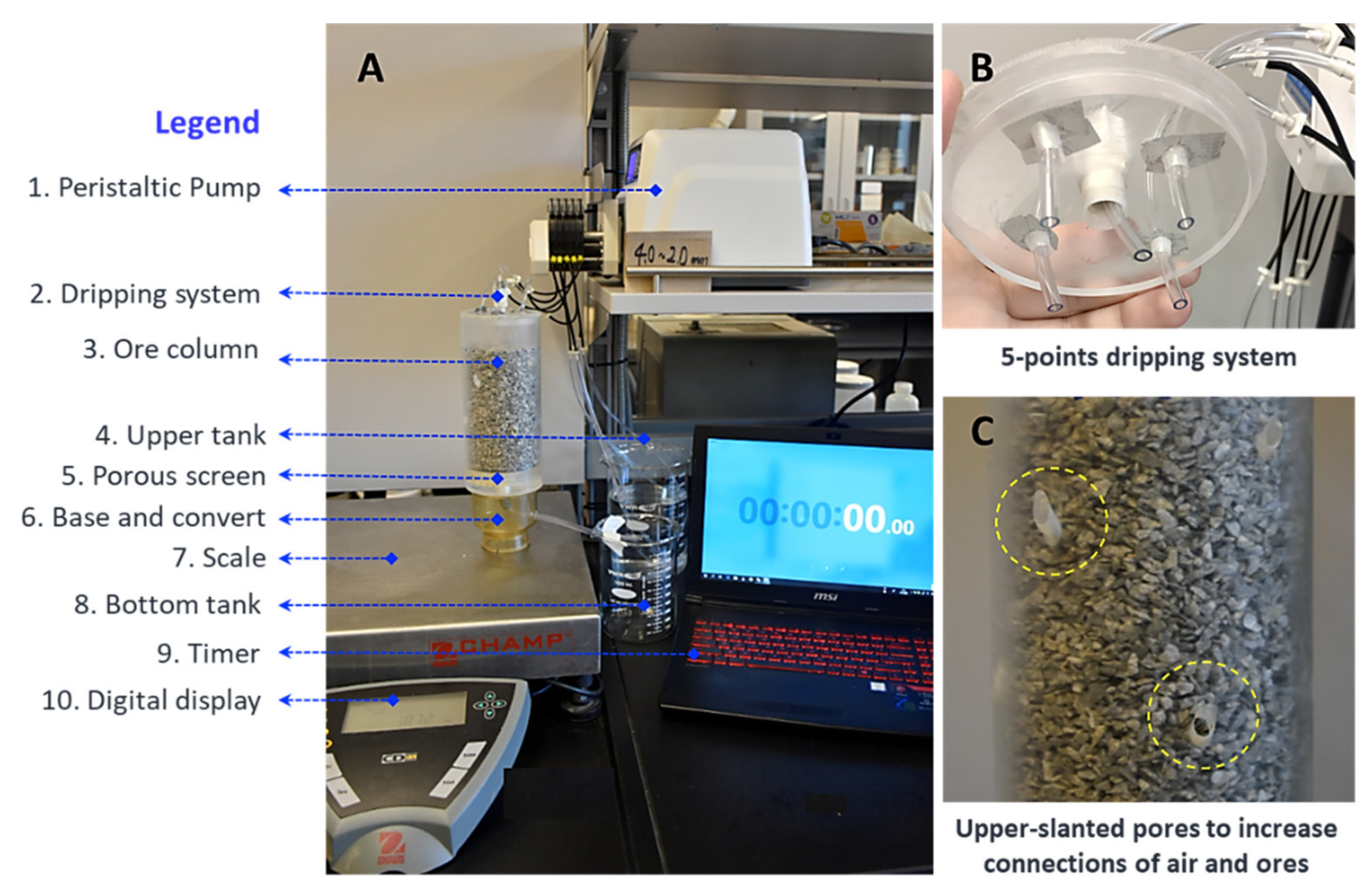

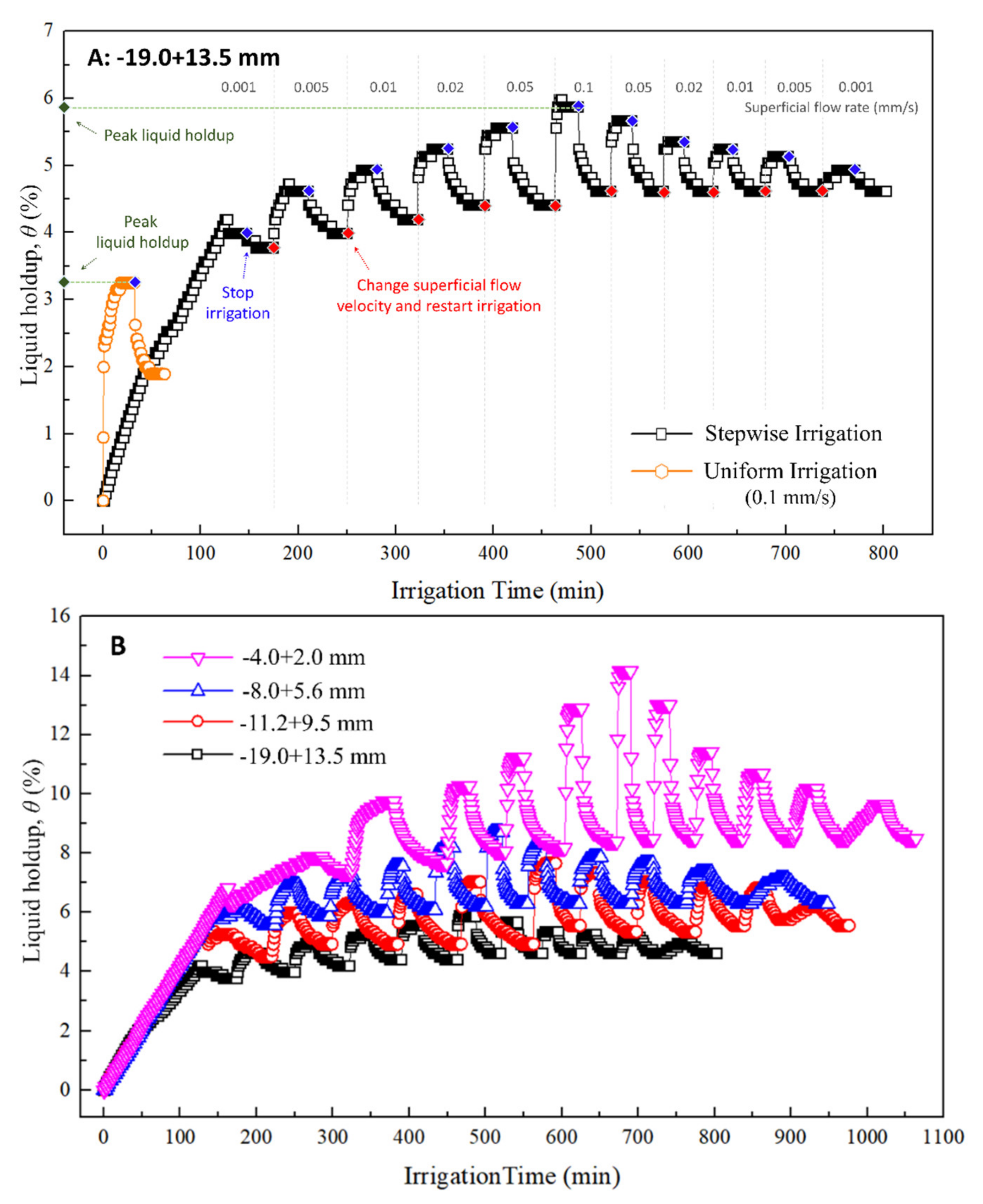
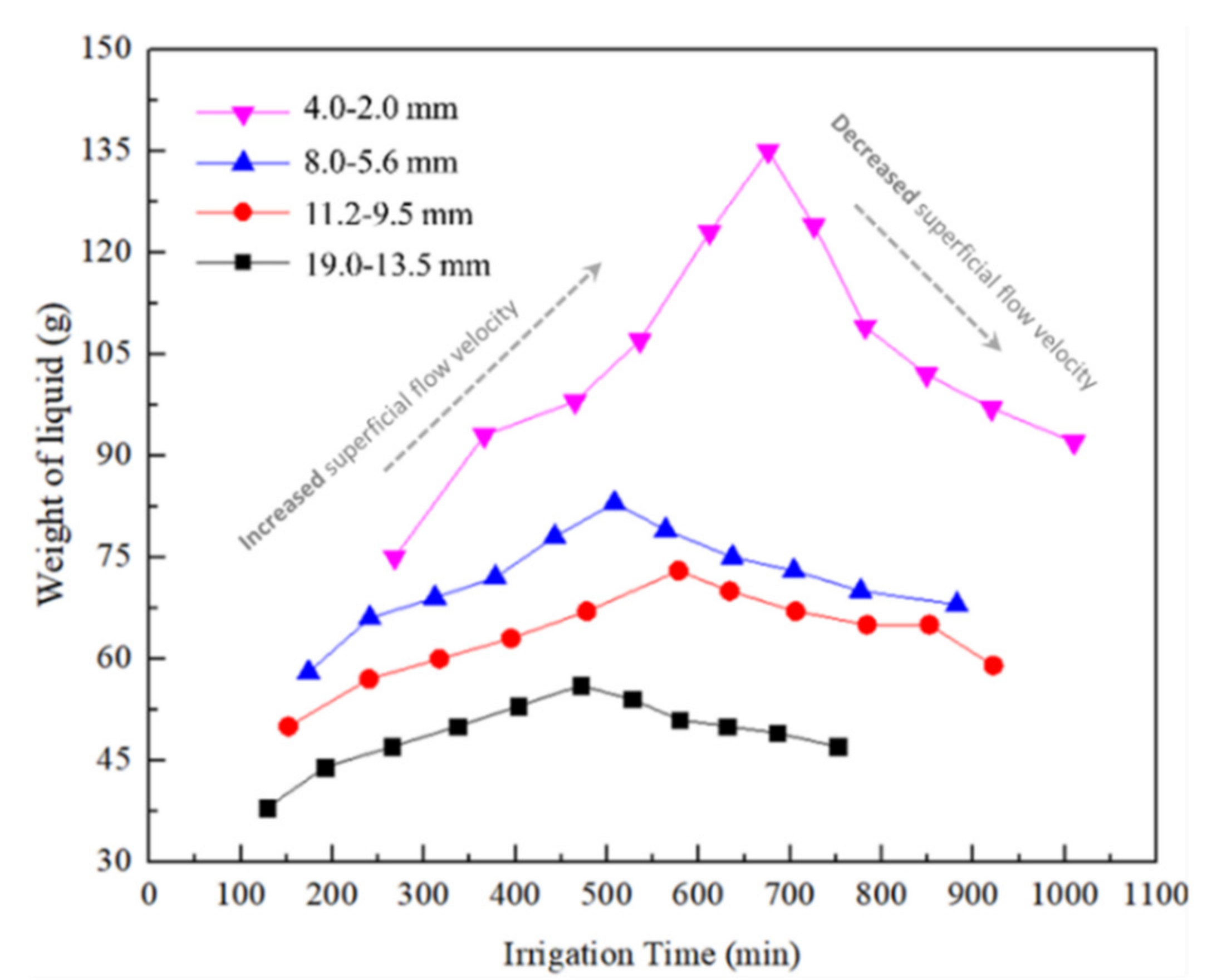
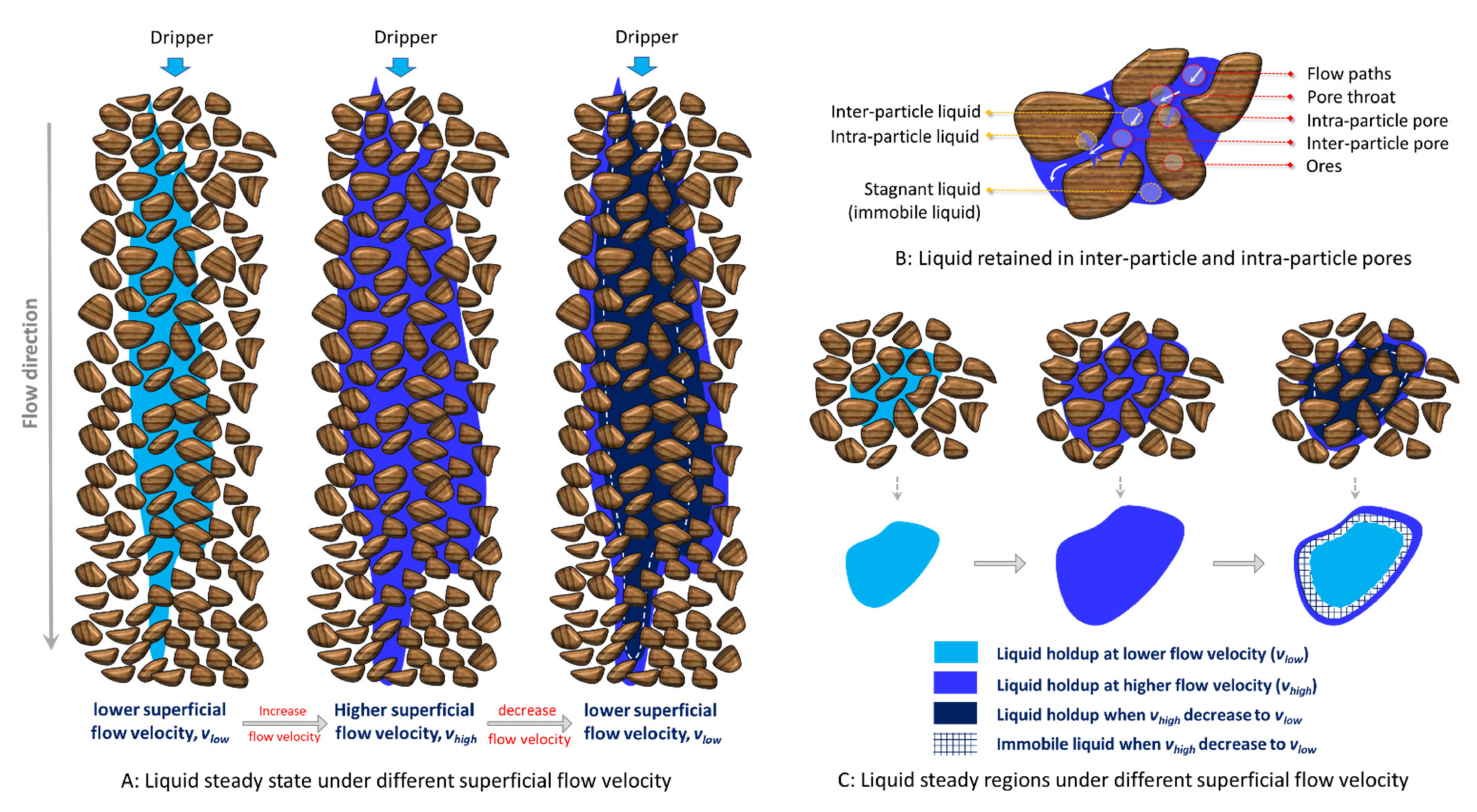
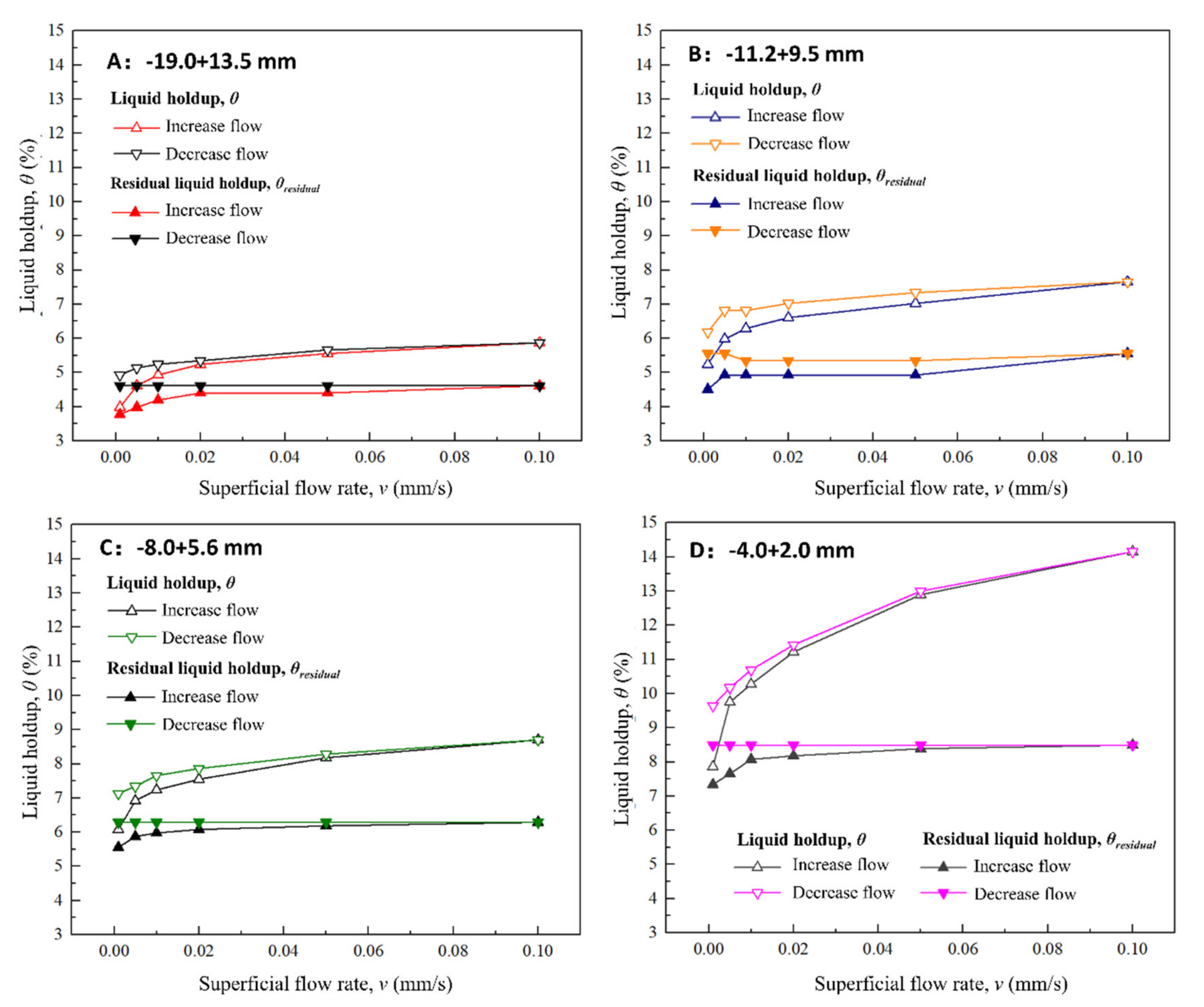
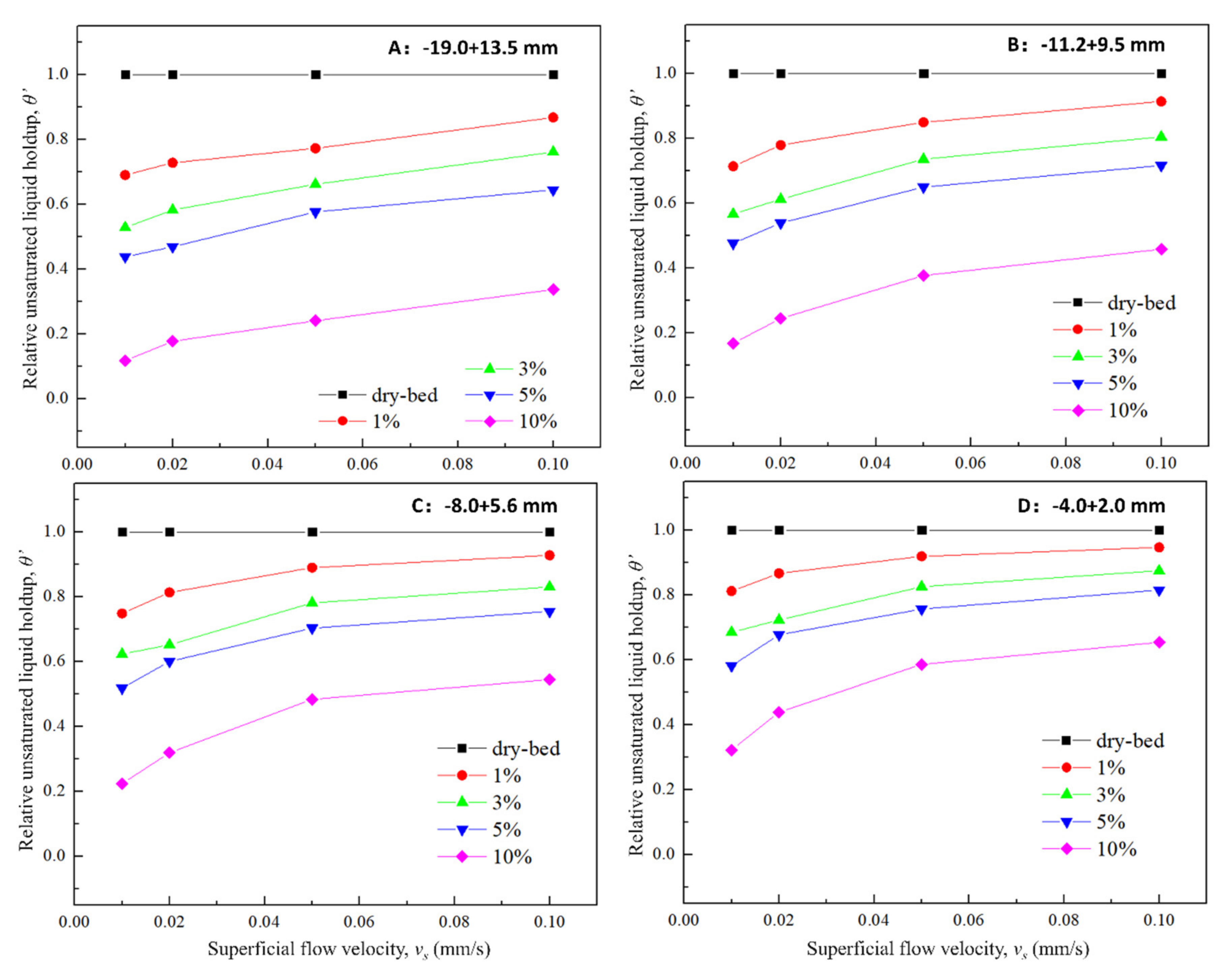
| Minerals | Mass Fraction (%) |
|---|---|
| Chalcopyrite (CuFeS2) | 0.6 |
| Pyrite (FeS2) | 2.7 |
| Illite (K0.65Al2.0Al0.65Si3.35O10(OH)2) | 18.0 |
| Plagioclase (NaAlSi3O8-CaAl2Si2O8) | 29.2 |
| Quartz (SiO2) | 34.5 |
| Others | 15.6 |
| Total | 100 |
| Particle Size (Geometric Mean Diameter), mm | −19.0 + 13.5 (16.02) | −19.0 + 13.5 (16.02) | −11.2 + 9.5 (10.32) | −8.0 + 5.6 (6.69) | −4.0 + 2.0 (2.83) |
| Relative Porosity | 0.143 | 0.143 | 0.159 | 0.176 | 0.196 |
| Irrigation Method | Uniform | Stepwise | Stepwise | Stepwise | Stepwise |
| Superficial Flow Rate, mm/s | 0.1 | 0.075~0.1 | 0.075~0.1 | 0.075~0.1 | 0.075~0.1 |
| Moisture Content of Wetted Bed, % | / | 0~10 | 0~10 | 0~10 | 0~10 |
Publisher’s Note: MDPI stays neutral with regard to jurisdictional claims in published maps and institutional affiliations. |
© 2021 by the authors. Licensee MDPI, Basel, Switzerland. This article is an open access article distributed under the terms and conditions of the Creative Commons Attribution (CC BY) license (https://creativecommons.org/licenses/by/4.0/).
Share and Cite
Wang, L.; Yin, S.; Deng, B. Understanding the Effect of Stepwise Irrigation on Liquid Holdup and Hysteresis Behavior of Unsaturated Ore Heap. Minerals 2021, 11, 1180. https://doi.org/10.3390/min11111180
Wang L, Yin S, Deng B. Understanding the Effect of Stepwise Irrigation on Liquid Holdup and Hysteresis Behavior of Unsaturated Ore Heap. Minerals. 2021; 11(11):1180. https://doi.org/10.3390/min11111180
Chicago/Turabian StyleWang, Leiming, Shenghua Yin, and Bona Deng. 2021. "Understanding the Effect of Stepwise Irrigation on Liquid Holdup and Hysteresis Behavior of Unsaturated Ore Heap" Minerals 11, no. 11: 1180. https://doi.org/10.3390/min11111180






